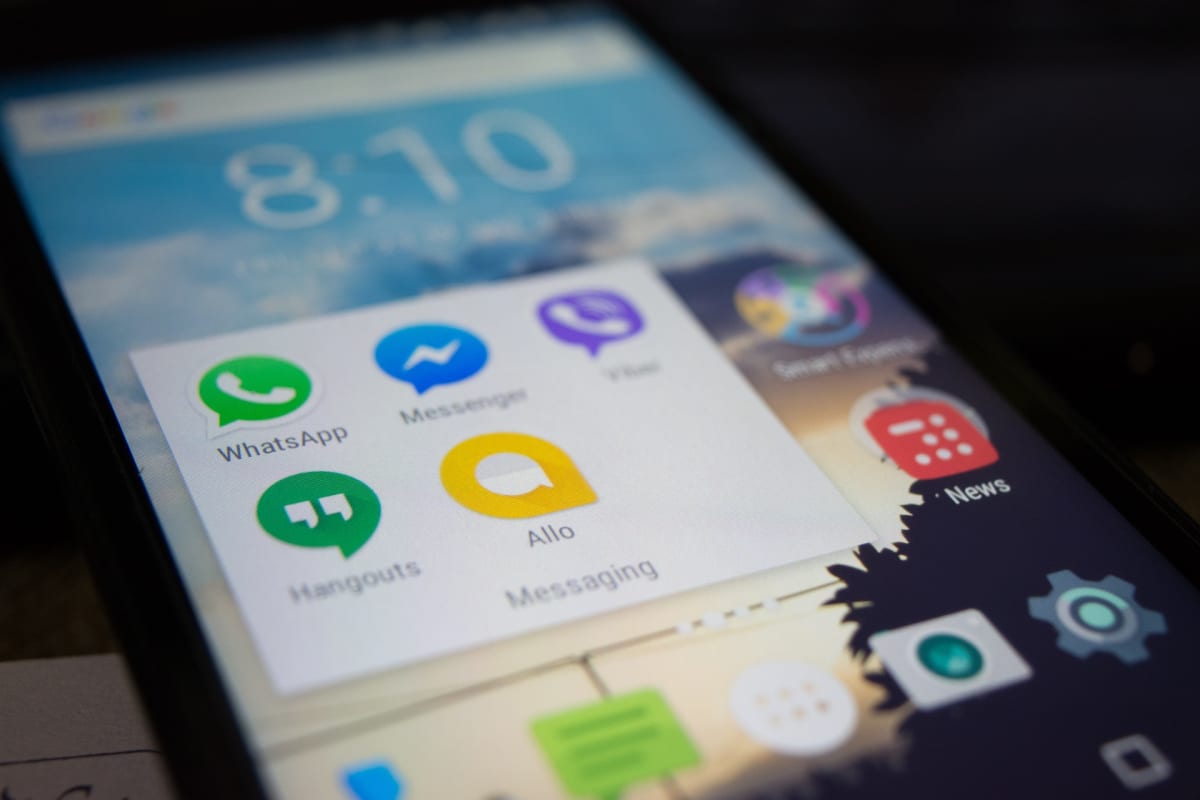What the heck is WhatsApp, and why should I care?
Published
technologysmartphonesfeaturedThe rest of the world uses WhatsApp, why not the US?

In February 2020, WhatsApp crossed the 2 billion user mark, and is now the world’s largest messaging service even though many people in the US have even heard of it. If you don’t use WhatsApp, now is the time to learn why it will be so valuable to have in Portugal and what you can do before you even move to get started using WhatsApp. But, before that, a bit of a history lesson.
Part 1: a little history
"Merry Christmas"—That was the first SMS text message sent in December 1992. By the late 90s, SMS texting was everywhere, and most of us can remember typing out 160 character messages on our cellphone keypads. SMS has plenty of limitations beyond the 160-character limit, so in 2002, mobile phone providers introduced MMS to address many of these limitations, including support for longer messages, short videos, images, and audio. While MMS was a big step forward, many limitations to SMS/MMS text messaging remained.
In 2007, Apple released the first iPhone. While not the first device to offer this, Blackberry and Palm had been at this for a few years, the iPhone and later Android phones brought internet-enabled smartphones to the masses. Now, that device in your pocket could use an internet connection to send messages instead of basic SMS/MMS. While this opened up a lot of new messaging possibilities in the US, there was an even bigger impact in other parts of the world, especially in Europe.
In the States, “texting” became incredibly popular. American cell phone companies were quick to offer generous monthly allowances for sending and receiving SMS/MMS text messages. Most Americans didn’t worry too much about roaming costs, as almost everyone they knew was also in the States. Finally, most Americans do not travel outside the US, so international roaming was rarely a concern. For Americans, good old-fashioned texting was cheap and convenient.
This was not the case in Europe, however. Many Europeans relied on low-cost, pre-paid mobile phone plans which were very stingy with SMS/MMS texting. Roaming was also a big issue when you had friends and family in other countries, or when you traveled to other countries. Europeans were ready for a messaging system that did not rely on expensive SMS/MMS systems.
In 2011, Apple added the iMessages instant messaging service to the Messages app on iPhones. Previously, Messages worked with SMS/MMS, but iMessages introduced many new features, such as delivery and read statuses, end-to-end encryption, group messaging and location data, to name a few. And, all these features worked over the iPhone’s internet connection instead of relying on SMS/MMS. All this great functionality came with one giant caveat; this only worked when all parties were using an Apple device. If the person on the other end was using an Android phone, then communication reverted to SMS/MMS, giving us the dreaded blue bubbles and green bubbles.
The US is one of the few countries where the iPhone leads in marketshare over Android phones, with approximately 58% of the market. In Europe, iPhones only account for roughly 35% of the market, with Android phones accounting for nearly 65% of users.
So, by the early 2010s, most Americans were happily sending their SMS/MMS messages or enjoying iMessages on their iPhones. Meanwhile, in European countries like Portugal, things were a lot more complicated. Texting was expensive, roaming charges were a problem while on vacation, and while iMessages looked great, most people didn’t have a compatible phone. If only someone would release an app that provided all the great features found in iMessages, but would also work on all smartphones.
And that’s where WhatsApp comes into play.
Founded by a couple former Yahoo employees in 2009, by the end of 2013, WhatsApp had over 400 million active users using the app and service each month. For many folks in Europe, WhatsApp was a great solution to their messaging needs. It wasn’t reliant on SMS/MMS, roaming charges weren’t an issue since it was internet-based, and it brought all these great messaging features to both Android and iOS, no more blue vs. green bubbles. Over the following years, the network effect kicked in, and WhatsApp became the de facto standard for messaging apps in Western Europe.
Part 2: What this means for you
As an American planning to move to Portugal, you have some decisions to make on how you communicate with people in Portugal, as well as with friends and family back in the States. Here are some important factors to consider:
- You require a widely used messaging platform that is used by the people you need to message.
- When messaging people back in the States, you require a platform that works over the internet and does not use SMS/MMS (more on this in a moment).
- Ideally, your messaging service should support advanced features including encryption, sending files, images and video, group messages, read receipts, and even voice and video calls.
- Your messaging service should be platform-agnostic and work equally well for iPhone and Android users.
Now, as you might have guessed, WhatsApp does a good job of addressing these factors, let’s break down each of them.
A widely used system
The network effect describes how something becomes more valuable simply because more people use it. This is particularly true for messaging systems. WhatsApp has less “value” in the US compared to Europe because fewer people use it there. But, In Portugal, WhatsApp use is the most popular messaging app. Chances are, if you need to message someone in Portugal, you will use WhatsApp. Many businesses use WhatsApp to connect with customers.
WhatsApp does not rely on SMS/MMS
Shortly after I moved to Portugal, I quickly learned that I simply couldn’t fire off a text message to friends and family back in the States. I had enabled Wi-Fi calling on my iPhone, so I was able to do this when my iPhone was connected to the internet. Also, if the other person was an iPhone user, things worked fine because iMessages kicked in and set the messages over the internet. But, things quickly broke down when trying to communicate with Android users or in group texts with a mix of iPhone and Android users. Things got even more complex when I would shift back and forth on my dual-SIM phone between my USA SIM/phone number and my Portuguese SIM/phone number. To this day, I still haven’t fully sorted it out and likely won’t because I gave up and went all-in on using WhatsApp.
Advanced messaging features
For the last few years, almost everyone I communicated regularly with used an iPhone. I became spoiled by having access to all those great features like read receipts, typing indicators, sending photos, having quick video or voice calls. Anytime I had to message an Android user, I felt like I’d gone back in time using primitive tools. Fortunately, WhatsApp seems to have full feature parity with iMessages, and even has one killer feature that iMessages lacks. WhatsApp also features strong end-to-end encryption, so it is very secure. But, since Meta/Facebook owns WhatsApp, your privacy might be at risk a bit.
Works equally well on Android and iPhone
Here’s where WhatsApp really shines. Once you’ve convinced your family and circle of friends to also use WhatsApp, everyone can now enjoy a level playing field. No more green vs. blue bubbles. Group messages run seamlessly, and you can easily share photos or have video calls with anyone else using WhatsApp, regardless of where in the world they are located.
Are there any downsides?
The only downside I can think of is that, since 2014, WhatsApp has been owned by Facebook (now Meta Platforms). I believe that Facebook/Meta is a shit company, and for the most part, the world is worse off for having this company exist. I’m loath to do anything that might, in some small way, benefit Mark Zuckerberg. But, thanks to the network effect, there really isn’t much alternative, short of buying everyone in Portugal a new iPhone, so we can all use Apple’s iMessages. So, I hold my nose and put up with it. But that’s just me, I’m sure plenty of people are ambivalent at best over Meta and the Zuck. Apart from that, WhatsApp is a solid app and service. I’ve rarely had any problems using it, and it allows me to communicate in ways I couldn’t even imagine 20 years ago.
So, how do I get started?
For the most part, the process is fairly simple, you visit either the Apple App Store or Google Play Store, download and install the app. The app and service are both free, and do not have ads. Once you have installed the app, you need to set up your account and profile, which is tied to your mobile phone number.
- If you have a dual-SIM phone, you will have to pick what phone number you want to use with WhatsApp. I recommend associating your WhatsApp account to your primary phone number.
- If you haven’t moved to Portugal yet, you will likely need to change the phone number associated with your WhatsApp profile after you move. Fortunately, that process is fairly easy.
Once you have entered the right phone number, you’ll get an old-fashioned SMS message with a verification code. After that, you can optionally import contacts from your phone, customize your name, upload a profile photo, and maybe even add a few notes about yourself.
After that, you’re ready to start messaging. If you imported contacts earlier, you’ll have some people to message already. If you need to add someone new, start with that person’s mobile phone number tied to their WhatsApp profile. After entering that person’s phone number, you can then start to send that person messages.
Once you have WhatsApp installed, you might have to sweet-talk some of your friends and family into using WhatsApp.
And even though making your life easier should be all the convincing they need, you could also point out that switching to WhatsApp would make group conversations with iPhone and Android users much easier.
And in conclusion…
Hopefully, you’ve found this wall of text somewhat helpful. Over the last few months, I’ve gone from a content iMessages user to now almost entirely relying on WhatsApp for all of my messaging requirements. It is my primary way to stay in touch with friends and family in the US, I use it almost exclusively for messaging friends and businesses here in Portugal. One way or the other, you will wind up using WhatsApp, but hopefully this guide will help you get the most of it.


